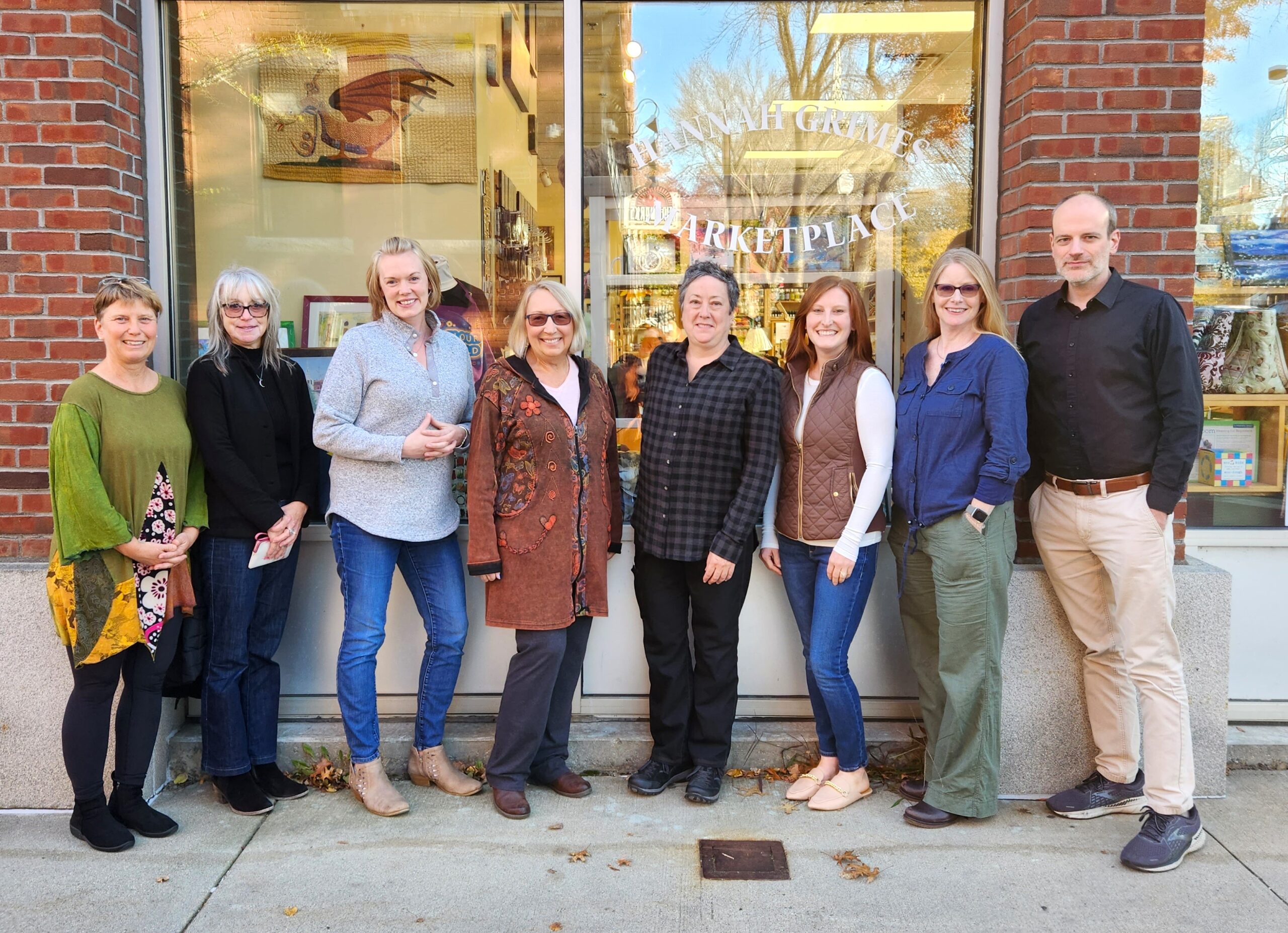The following case study was developed as a part of the Radically Rural project funded through a Northern Border Regional Commission grant.
Early Origins: 1991–1997
Mary Ann Kristiansen, founder of Hannah Grimes, came to the Monadnock Region of New Hampshire in 1991. She quickly invested herself in the artisan community in the region and was dismayed when she learned that there was no local market for the products she and her fellow artisans were producing. At that time, the Buy Local movement didn’t exist, and many didn’t realize the potential it had for rural communities trying to transform economies that had been built on manufacturing for more than a century.
Mary Ann’s vision was to reconnect the purchasing public with the skilled artisans around the uniqueness of place – her place – the Monadnock Region, NH. Her first venture was a local festival, The Traditional Craft & Industry Fair, that she held at her home in 1994. Conceived as an event where buyers and sellers could connect, it attracted more than 400 people and demonstrated that the community was interested in supporting the local economy. The Fair grew and relocated from Mary Ann’s home to a local farm where it continued as an annual event. The Fair’s success fueled Mary Ann’s ambition and vision and planted the seeds for a community that took pride in its local artisans, would purchase from them, and would spread the word that purchasing locally had value. She had successfully set the stage for the founding of Hannah Grimes.
From Founding to the COVID-19 Pandemic: 1997–2020
Hannah Grimes Marketplace (1997-2020)
Although Mary Ann’s efforts at building a community interested in buying local were taking root, she and her fellow artisans were struggling to sell their wares for reasonable prices. They also lacked the business know-how to grow their business. She saw a need in her community, but much of the infrastructure to buy and sell and trade with neighbors was gone. Mary Ann wanted to provide a physical marketplace, where local artisans could sell their products and develop business skills and where local customers had a convenient, single downtown location to buy locally made products.
About this time the Monadnock Economic Development Corporation (MEDC), headed by Jack Dugan, purchased a strip of buildings on the eastern side of Keene’s Main Street. Mary Ann was invited to fill a property with a nonprofit venture, the Hannah Grimes Marketplace, to create a thriving market for locally made and grown products and to help build the businesses of the people who make and grow those products.
Named the Hannah Grimes Marketplace in honor of the woman who had inspired Mary Ann’s journey, the retail store opened in November 1997, first in a temporary space due to construction delays, and then finally in its permanent location at 42 Main Street in June 1998. MEDC offered a lease with friendly and supportive terms.
Even with that boost, making the leap from home-based fair to main street retail was a daunting task. As with any venture in its start-up phase, numerous challenges had to be overcome to open the Marketplace, but Mary Ann faced them with zeal and persistence (and some classic entrepreneurial naivete). The first challenge was securing essential funding to furnish the store and to provide necessary operating capital. The NH-CDFA provided a loan and in securing this loan, Mary Ann established a relationship with the NHCDFA that has continued to the present day. The second challenge was filling the space with local artisan wares, but local connections from her spinning group and the Fair formed a core who spread the word — there would be a place for local artisans to sell their goods and find community. The third challenge was tending to the day-to-day operations of a retail store with daily tallies, sales goals, and marketing. It was entrepreneurship on a completely different scale. But locals were learning that purchasing from local artisans had value to the broader local community, that knowing who made an item of clothing or cheese had a coolness factor that can’t easily be measured long before the Buy Local Movement emerged. The Marketplace was shaping into a successful enterprise.
The final challenge was somewhat unexpected: the IRS proved reluctant to give the Marketplace nonprofit status. After several years of back and forth, in 2001, Hannah Grimes created two separate legal entities: a 501(c)3 nonprofit, the Hannah Grimes Center for Entrepreneurship (HGC), and a for-profit business, the Hannah Grimes Marketplace, which is wholly owned by HGC. Although this is a more complex structure for the organization, it has the unanticipated benefit of keeping the entire Hannah Grimes enterprise firmly rooted in the joys and challenges of running a business. It inspires us, educates us, humbles us, and ultimately provides us with credibility with the entrepreneurs (artisans and others) who we serve.
Hannah Grimes Center for Entrepreneurship (2004-2020)
When developing the operational model for the Marketplace, Mary Ann recognized that the artisan vendor businesses needed and wanted help developing their business skills. She provided 1:1 help and informal trainings, but she aspired to do more.
In 2004, Hannah Grimes received a USDA grant to run a one-year program, The Entrepreneur Project, which brought together a cohort of businesses for monthly meetings facilitated by a business coach to offer a next level of business support to some of the more ambitious Marketplace members. At its conclusion, the five businesses in the program had 30% year over year growth and added, on average, one new employee per business. Hannah Grimes had discovered a model for deepening and enriching our support of growth-oriented businesses.
Only a year later, in 2005, MEDC, still led by Jack Dugan, invited Hannah Grimes to take over operations of their business incubator. MEDC had launched the incubator in a space just one block off Main Street, but they had failed to attract businesses. Hannah Grimes seized the opportunity as it offered two significant opportunities. First it allowed Hannah Grimes to use the programming developed with the Entrepreneur Project to serve not only more Marketplace vendors, but also entrepreneurs in other sectors. Second, it gave Hannah Grimes much needed office space, complete with meeting and conference rooms. Hannah Grimes turned the incubator around in short order. The incubator went from empty to full in only four months by attracting a new set of entrepreneurs through programming designed to improve the success of early-stage businesses and desirable low-cost office space. A community formed at the Center, adding the “secret sauce” ingredient of all Hannah Grimes ventures.
As space and programming expanded, the entrepreneurs being served by Hannah Grimes also expanded from artisans to entrepreneurs from all sectors, of all sizes, and in every stage of business. Of particular pride and significance to the Center was our success at reaching the often-overlooked entrepreneurs – women entrepreneurs, low-moderate income entrepreneurs and BIPOC entrepreneurs.
Based on the continuing success of the Marketplace and the new success of the Center, Hannah Grimes was poised for growth. Over the next decade, programming expanded and developed to include a full range of services. If an entrepreneur needed it, the Center found a way to offer it. Volunteer specialty coaches were recruited; the Entrepreneur Project curriculum was reinvented multiple times, ultimately developing into a set of cohort-based programs for businesses at every stage; and pitch events were added to increase the flow of local investment to local entrepreneurs.
Keeping pace with the growth required the Center to cross significant organizational thresholds at the same time, even as it also had to ride the economic ups and downs, including the Great Recession of 2008. It expanded the Center staff from one (Mary Ann) to three. It raised $2.2 million for facilities in four separate campaigns which enabled the Center to purchase and significantly renovate its building into a bustling office/co-working space and community center for entrepreneurs starting and growing both businesses and nonprofit organizations. The ability to use the co-working space in multiple ways supported new ventures beyond the typical businesses such as architects and marketing consultants to more whimsical ventures such as a live music venue which launched from there and grew into a restaurant/art bar and nonprofit ventures such as a new church.
CONNECT to Radically Rural (2008-2020)
In 2006, the Center launched a fall CONNECT event to bring together the growing network of alumni from multiple Entrepreneur Project cohorts. In just a couple of years, this event was opened to all in the Hannah Grimes community. And ten years later, in 2016, Hannah Grimes partnered with the Keene Sentinel to transform the event from a Hannah Grimes gathering into a high-energy, themed event for the entire local community and nearly tripled the attendance from 150 to 420.
Inspired by the reception, the partners decided to expand the event into a full-fledged national conference where rural champions could gather and share “what’s working.” In 2018, Hannah Grimes and the Keene Sentinel hosted the first ever Radically Rural Summit, welcoming 544 innovative, rural leaders from 24 states with programming across five thematic tracks: Main Street, Arts & Culture, Community Journalism, Land & Community, and Rural Entrepreneurship. The CONNECT event became the main networking event on the evening between the first and second days. At the second Radically Rural Summit in 2019, 586 attendees from 25 states were welcomed, and a Clean Energy track was added to its lineup. In 2021, Radically Rural introduced an All in for Health track. Focused on sharing solutions, rather than lamenting problems, the Summit galvanized and equipped attendees to make positive change in their own communities.
Read the whole case study here.
Written by Alison Chisolm, Consultant Squared.

